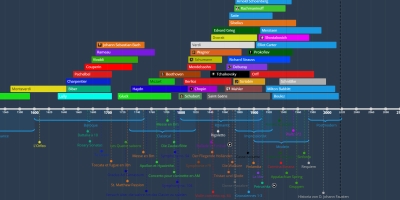1 jan 1028 ano - Birth of modern musical notation
Descrição:
~1028 : An Italian monk named Guido of Arezzo describes in the Epistola de ignotu canto, a letter destined for a fellow monk, a process allowing to read a chant never heard before. This process involves the Ut Queant Laxis, a lithurgical hymn to Saint John the Baptist (see attached image). He proposes to memorize the first syllable of each of the first six lines (ut-re-mi-fa-sol-la) and their relative pitch to describe any melody.Guido of Arezzo also improved the existing neumatic musical writing by adding a stave made of 4 lines indicating precisely which note to sing (neumes only indicated vocal inflexions as they were only used as aide-mémoires).
13th century : appartion of staves made of 5 lines instead of 4.
17th century : the note "ut" was replaced with "do" (for DOminus meaning Lord or after the Italian music theorist Giovanni Battista DOni), as it was easier to sing. A seventh note, "si" (for Sancte Iohannes), was also introduced.
Adicionado na linha do tempo:
Data:
1 jan 1028 ano
Agora
~ 997 years ago

